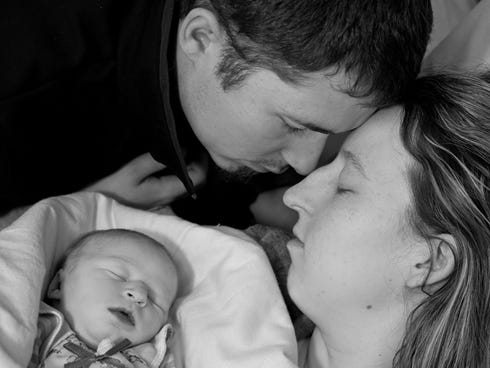Report: 4 inexpensive products can save newborns

Jonathan and Angela Rodman with their daughter Charlotte. "When Charlotte died shortly after birth, I felt isolated," says Angela Rodman of Salem, Ore. "Charlotte's sudden death led me to reach out and connect with others who have lost babies. There are more of us in this country than people realize." / Theresa McKeegan
This Mother's Day, many women will squeeze their children in their arms while others will have to hold their babies in their hearts.
A report released today shines light on the plight of women whose babies died shortly after birth.
More than one million babies die on their birth day every year worldwide, according to a report from Save the Children, a non-profit that aims to improve the lives of boys and girls in need around the world.
That makes a baby's first day the riskiest day of his or her life - in the USA and other countries, according to the 14th annual State of the World's Mothers report. Released in the run-up to Mother's Day, the report aims to increase awareness of the needs of mothers and children around the world.
The leading causes of newborn deaths are prematurity, birth complications and severe infections.
"It's hard to imagine the depth of one mother's pain in losing her baby the very day she gives birth, let alone a million times over," says Carolyn Miles, president and CEO of Save the Children, which is based in Westport, Conn. "Yet, this report is full of hope. It shows there is a growing movement to save newborn lives and growing evidence that we can do it."
Four products costing between 13 cents and $6 each can save newborns - many on the first day of life, Miles says. Resuscitation devices can help babies breathe, and the antiseptic chlorhexidine can prevent umbilical cord infections. Injectable antibiotics can treat infections, and steroid injections for women in preterm labor can help premature babies' lungs develop.
Save the Children, which does not sell products, aims to make sure that health workers in high-risk countries have the supplies they need to save newborns. The organization works with health officials and donors to make the products available. Save the Children is funded through a variety of public and private sources, including corporations, foundations, individual giving and the United States Agency for International Development.
"As we come up on Mother's Day, we'd like for mothers to think about what other moms are facing around the world," Miles says.
Angela Rodman, 29, of Salem, Ore., says the timing of the report around Mother's Day is helpful. "It brings awareness to all mothers - not just the ones who have children who are living but also the ones who only have children in their hearts," she adds.
Rodman's daughter, Charlotte, died on the day she was born - May 14, 2010. Rodman, who has a 1-year-old son and is pregnant, shares her story to raise awareness about newborn deaths. "It's important that moms and dads know they're not alone," adds the stay-at-home mom, who writes a blog. "It is a very difficult journey, but it can be got through."
The report also features the 14th annual Mothers' Index, a ranking of 176 countries that looks at the health and well-being of mothers and their children. It looks at maternal health and child well-being as well as educational, economic and political status. Finland is named the best place to be a mother and the Democratic Republic of the Congo is ranked as the toughest.
The USA comes in 30th place. In this country, women face a 1 in 2,400 risk of maternal death. The under-5 mortality rate is 7.5 per 1,000 live births. In addition, women hold only 18% of seats in Congress.
Top 10 countries in 2013 Mother's Index

No comments:
Post a Comment